History of
Agriculture
Prehistoric Technology--agriculture
was the invention that allowed larger communities with division
of labor, therefore more progress
- Jane Goodall has shown that chimpanzees
use
tools in the same sense humans do, as do orangutans
- new evidence that birds
use fire
- paleontologists find that early species of
humans, as much as 3 million years ago, used fire
and produced
simple tools. But in primitive societies there is
little division of labor so the work process tends to stay
very simple.
- hunting and gathering seems to be an easy
life--12 to 19 hours of work a week--so why develop
agriculture?
- less than 10 thousand years ago agriculture was
invented in northern Iraq, and within a few thousand
years independently in other parts of the world--China,
India, central America.
- slash and burn agriculture did not make much
difference, because it cannot support large populations.
- Irrigation
is the key to the development of cities because it supports 14
times the population on the same area of land. It takes
twice the labor as dry farming.
- Mesopotamian
writing:

Ancient World--progress was limited by attitudes
towards technology in Europe and the Middle East
- labor demands increased as a result of
technological advance, but it also allowed specialization--the
invention of government, writing, and
in general of civilization. This second revolution
happened in Egypt and Mesopotamia about 3000 BCE.
- This meant the opportunities of a market, but
at first opportunities to do new things were very limited by
people's beliefs
- belief that the physical world was
controlled by Gods who behaved irrationally (example: Mesopotamia)
- slavery--you don't need labor-saving devices
if you have slaves to do the hard work
- the attitude that practical life was beneath
the dignity of educated men (example: Hellenistic
Alexandria)
- Plutarch
said of Archimedes: "Although his inventions had won for him
a name and fame for superhuman sagacity, he would not
consent to leave behind him any treatise on this subject,
but regarding the work of an engineer and every art that
ministers to the needs of life as ignoble and vulgar, he
devoted his earnest efforts only to those studies the
subtlety and charm of which are not affected by the claims
of necessity." (a
source)
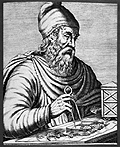 Archimedes
Archimedes
The fall of Rome resulted in a near-complete collapse of
civilization
- barbarian tribes took over
- literacy was nearly lost
- slavery became impractical and the idea developed
that it was immoral to hold Christians as slaves
- civilization had to be rebuilt on a new foundation
(Christianity)
- the only functioning organization left was the church
(Catholic)
The Middle Ages in Europe (700-1400 CE)--technological
progress and economic changes
- Europe became more technologically
advanced than China
only after about 1350
- during the middle ages (also known as the
medieval period) European technology began to progress
while the Chinese increasingly believed that innovation
was a bad thing.
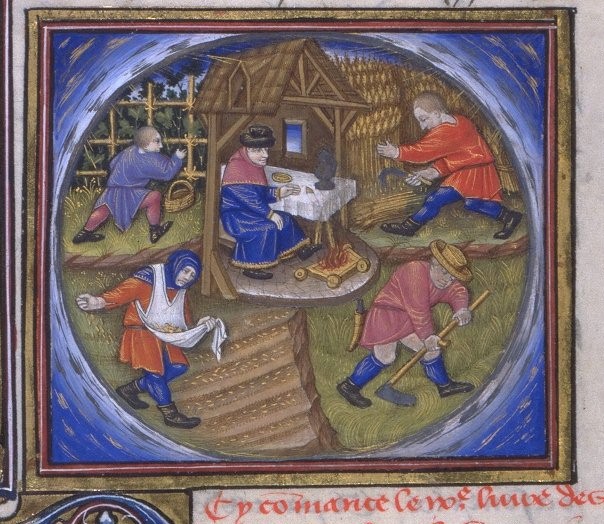
the four season, from bnf.fr
Agricultural changes increased the
amount of food one farmer could produce:
- The mouldboard
plow (8th century, also known as the heavy or wheeled
plow) turned the soil--needed on wet soils in northern Europe
- required 6
to 8 oxen to pull so led to cooperative farming
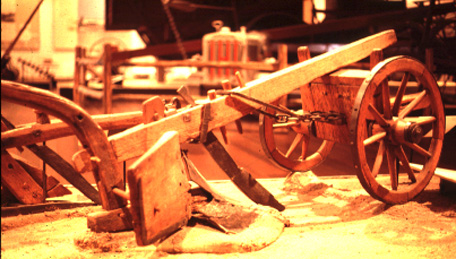
PEM photo: Mouldboard Plow, National Museum of American History
- Three field crop
rotation (9th century)
- winter wheat or rye
- spring
oats, beans, or barley
- fallow
- 2/3 of the fields produced food each year
instead of the old system where half the fields were left
fallow
- signifcant land was reserved as common land
for pasturing animals and gathering firewood.

- Horsepower replaces oxen (widespread by 12th
century)--horse could work for more hours a day and moved 50%
faster
- oats (oxen can work on grass alone)
- the
horse-collar (8th-9th century)--allows a horse to pull
4 or 5 times more weight.
Horse-collar
-
iron horseshoes (common by 11th century) allowed
horses to work on wet ground
- the
stirrup made possible the mounted knight, creating a
demand for more and better horses
Feudalism gave farmers somewhat more freedom to
adopt new technologies: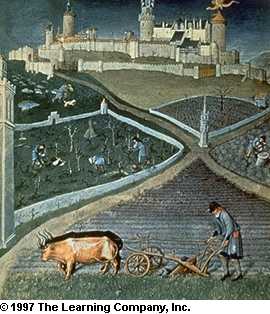
- --Manorial
System : the serfs (not a slave, but bound to the
land--cannot move away) lived in a village and farmed the
land communally, giving a share of their labor and the crop
to the knight
- --the knight and his family lived in the
castle and had responsibility to protect the serfs and to
fight when called up by the king
- --theoretically the king owned all the land
and gave the lords the right to use it in return for
military service, the lords then divided it up among knights
on the same deal
- --such
government as there was was provided by the knights
and lords
- --the farmers had
some opportunity to better themselves by improving farming
practices
Water Power began to be used in place of human
muscle: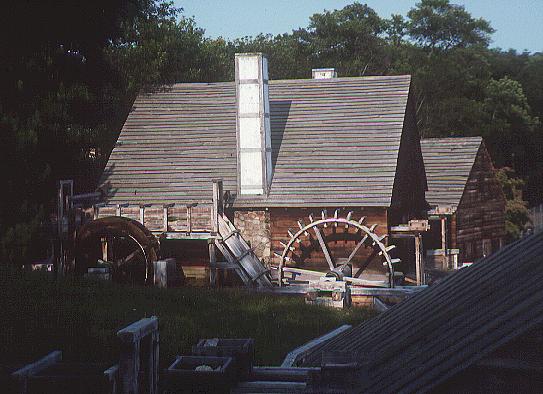
- invented in Roman times but used only rarely
through the 5th century
- Spread of the water
wheel in the 8th and 9th centuries
- In 1086 the Domesday Book
lists 5624 mills in 3000 English communities--an
average of one mill for every 50 households
- first
mills were floating mills or mills attached to
bridges. They first had undershoot wheels (20-30%
efficient), then overshoot (50-60% efficient, 13th century)
with the water directed by a canal or a wooden millrace
- the invention of the cam allows the
conversion of rotary motion into reciprocating motion
- new uses for water power:
- around 1000: fulling
wool cloth, beating hemp, water driven trip hammers to break
up iron ore

- around 1100 water powered bellows,
edge runner wheels to crush olives for oil
- around 1200 saw mills that used water
power both to power a rotary saw and to feed in the log
- around 1300 water powered grindstones,
pumps to remove water from
mines
- damming a river for water power--1177
Toulouse had 3 dams with 43 mills. The largest dam was
1300 feet long
-
windmills (12th century) used in areas where land was
flat or streams froze in the winter
 23. Life
and Miracles of Saint Louis
23. Life
and Miracles of Saint Louis
Christianity
and attitudes towards technology in the Middle Ages
- motivation to go out and spread Christianity
- God no longer inhabits nature
- Man's dominion over the earth--new attitude
- monasteries developed and spread technology
because they needed it to be self-supporting on marginal land
and because they believed work was virtuous
- monks work with their hands--the first
intellectuals who got their hands dirty (
The Cistercians )
- Christianity prohibited the owning of
Christians as slaves so slavery became much less common
- Cathedrals were a technological achievement
with a religious purpose--competition to build taller both for
civic pride and because people saw it as getting closer to God
(a
medieval mason, images
of medieval art and architecture)
- the invention
of the clock in the late 13th century--at a
monastery
The Early Modern Era from 1450 to 1750 saw
further technological innovations and changes in thinking.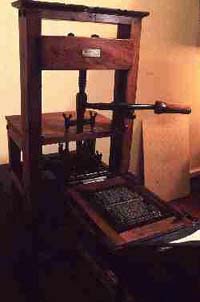 The printing press
allowed knowledge to spread more quickly and reliably:
The printing press
allowed knowledge to spread more quickly and reliably:
- medieval books cost $2000-10,000 in today's
money
- the first universities developed in the
middle ages, and the demand for books was so high that some
workshops had a kind of mass production with one person
reading and a number writing
- paper was already mass produced, the screw
press and oil-based inks used for wooden block prints
- Gutenberg's key innovation (in 1452) was
moveable type (more
history )
- by 1483 the same amount of money would
produce 3 hand copies of 1025 printed copies
- the cost of a book dropped to a few hundred
dollars in today's money
- by 1500 8 million books published--equal to
total previous world output
impact:
- students didn't have to spend all their time
memorizing the books
- more books available meant it was easier to
compare books and notice contradictions
- more accurate and faster transmission of
knowledge

- people read the Bible for themselves,
leading to the reformation
- Luther takes his stand in 1517--argues
that we are saved by God's grace not by good works and that
everyone has the right to interpret the Bible for themselves
- in 1531 Henry VIII breaks England away
from the Catholic church
Scientific Revolution ( a
somewhat more detailed overview ):
- Copernicus
published De Revolutionibus Orbis Celestium in
1543. He was a priest motivated by the need for calendar
reform, but his argument that the earth goes around the sun
(instead of vice
versa) started the downfall of Aristotelian science
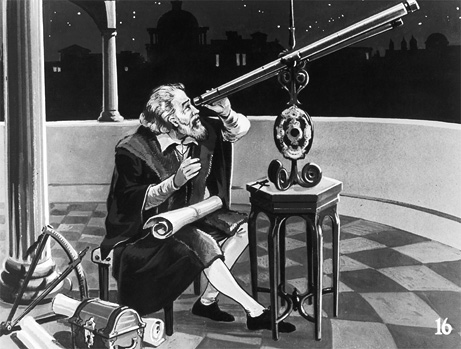
- Kepler
published the theory that the planets move in elliptical
orbits in 1609.
- Galileo
published his defense of the Copernican system in 1632 and his
new physics in 1638. Galileo is most important because
he put into place a new scientific method in which scientists
argued from experiment and from his observations with the
telescope, not from logic alone.
- Newton
published the law of universal gravitation in 1687. He
was slowed down a bit because he had to invent calculus in
order to show that his theory worked.
Exploration:
- the problem of navigation was not solved
during the age of exploration
- magnetic
compass introduced in 13th century, but knowing which
way you are going doesn't help much if you don't know where
you are
- more careful map-making was the main
improvement of the 14th and 15th centuries, particularly
knowledge of the winds
- minor improvements in methods for
measuring latitude in 15th century
- the problem of measuring longitude was not
solved until the mid to late 1700s ( story)
- in 1340 the Muslims cut off overland trade
to Asia and Europeans start exploring outside the
Mediterranean
- slow exploration down the coast of Africa
until Bartholomew Dias rounded the Cape of Good Hope in 1487
- Columbus underestimated the circumference
of the earth and reached America in 1492
- in 1519 Magellan
set out on a 3 year voyage around
the world
the full
rigged ship (about 1500--only one of Columbus's ships was
the new design)
- multiple masts and more than one sail on
each mast
- rudder
permanently attached to a stern post instead of a
steering oar
- rounded shape
- military technology was also critical,
because of the fighting to control sea routes
- primitive cannon
about 1325 used carved stone balls and exploded a lot
- iron cannonballs introduced 1350, corned
gunpowder for more even explosion about 1420
- cannon became safe enough to use
on a ship about 1500
- very quickly warships began carrying large
numbers of cannon--England rose to power partly because they
were more successful in making iron cannon (because they
happened to have high-phosphorous ore)
The Industrial Revolution began in
England
Improvements in agriculture helped start
the industrial revolution and were crucial to its success
notice also what life was like for farm laborers, to provide
a comparison with the lives of factory workers
Leading up to the
industrial revolution, the key change was Enclosure, a
change in how the use of agricultural land was organized
- key to agriculture becoming more efficient
- land ownership:
- the owners of the land were rich upper class families
- they leased the land to villages whose residents
cooperated to farm communally but different families has the
right to the produce of different amounts of land
- during enclosure the landowners wrote new leases to
individual families--often 19 year leases
- every family in that village had the right to get a
lease for an amount of land equivalent to the rights they
had before
- the replacement of communal farms with family farms was well underway
before the industrial revolution--started on the
basis of agreement of villagers but was increasingly forced
after 1760
- communally farmed land and common
land were divided up into family farms, each family
getting an equivalent share to what they had before
- people who got very small farms couldn't survive on their
own without the right to use the common (because it has been
divided up too) and had to sell out, so farms got larger
(several hundred acres)
- family farms (on leased land) worked by the family and
some hired agricultural laborers (at first fairly often hired
on an annual basis)
- this was key because it gave opportunities to those
farmers who were interested in improving--they could invest in
improving their land or new crops
- End result of this process of enclosure & farms
getting larger was a pattern of large family farms on land
leased from an upper class landowner:
- Farms of 200-500 acres
- One family held the lease and makes decisions
- That family could invest in improvements and get
profits

- 15-20% of the land was owned by the farmers themselves,
75% by large landlords, usually the old aristocracy whose
families had owned the land for many generations
- farmers did often have 19 year leases--farm size refers
to the size of the farm a family leased and managed, not the
land owned by a landlord
- the small farmers who sold their land rights mostly
become agricultural laborers but some moved to cities
- the overall labor surplus kept wages down
- in a few areas people were moved off the land to increase
pastureland for sheep
- it is somewhat oversimplified to say that poor people
moved from rural areas to the cities and provided the labor
force for the industrial revolution
- but agriculture certainly made a difference because it
allowed population increases and fed an increasing population
of city-dwellers
Rural Poor:
- even before the industrial revolution there were
leaseholders who controlled land and laborers who had no land
rights and worked for money (or food)
- enclosure benefits the remaining leaseholders, but more
people become laborers
- before the industrial revolution, farm workers had been
hired annually and fed by the farmer, as the industrial
revolution developed the system changed, farm laborers were
hired when needed and paid weekly wages
- why? disappearance of feudalism, more emphasis on
profit
- the system of relief for the poor--poor laws--was based
on the idea you could only get help in the place where you
were born
- population began to grow more rapidly, more food
- the poor had large families because more children meant
more wages and with the early poor law reform called the
Speenhamland System, actual cash benefits
- Hobsbawm writes about the Speenhamland system, which made
the situation worse by encouraging people to have more
children and providing benefits only if they stayed in the
parish where they were born (discouraging them from moving to
find work)
Improved
agricultural technology (needed for the industrial revolution
to continue to grow): early
timeline
a turnip slicer because horses can't
manage whole turnips
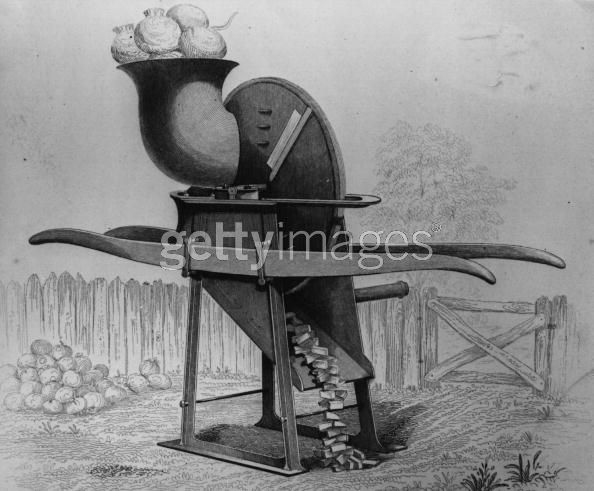
- the amount of land in cultivation increased because of
the enclosure of common land
- four
field
crop rotation--wheat, turnips,
barley or oats, clover or alfalfa
- consider a 500 acre farm
- after enclosure the common land becomes
cropland instead of permanent pasture so cultivated land
increased from 360 acres to 480 acres
- the number of animals kept doubled, to 25
horses, 80 cattle and 350 sheep, who eat clover or alfalfa 9
months of the year and turnips in the winter
- these provided enough manure to fully
fertilize the land, increasing grain yields by at least 10%
- labor needed increased from 15 to 21
year-round laborers, increasing the incentive to mechanize,
but the new farm did not need any more labor during harvest
than the old
- the earnings of the farm increased because
of higher grain yields and because there were more animals,
so the total revenue increase was 24%
- turnips and hay crops make it possible to keep
more livestock over the winter and therefore to have more
manure for fertilizer
- new willingness to try new things in
agriculture--
- new scientific approaches to farming.
willingness to experiment
- one of the pioneer scientific investigators of
agriculture was an Englishman named Jethro
Tull, who introduced an improved seed
drill
in 1701 and did systematic experiments to see what worked
- these technologies at first spread very
slowly--they were widespread by 1800
- importing of fertilizer (guano from South
America)

- breeding of improved
livestock (eg. Herefords)
- fencing and drainage, including laying
clay pipes under the fields after 1843
- mass production reduced the cost of tile pipes
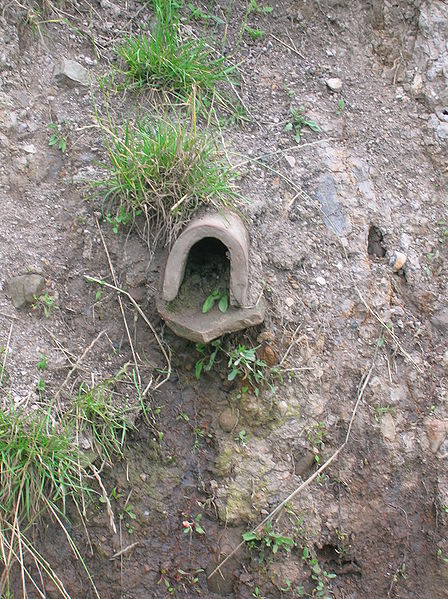
- average agricultural surplus per worker
doubled from about 25% to about 50%
Rapid industrialization meant more demand for food and
therefore required further innovation in agriculture--improved
science and technology for agriculture were as much a result of
the industrial revolution as a cause. Capitalism was coming
to agriculture
Agricultural
Developments in the US:
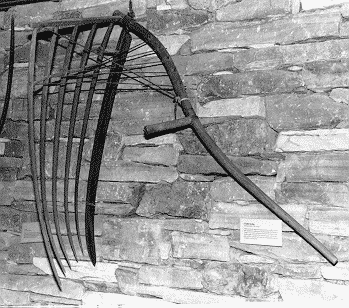
Scythe
with
cradle
Labor involved in growing 100 bushels of wheat
- 1830 250-300 hours by hand
- 1890 40-50 hours by
horse-drawn machine
- 1930 15-20 hours with a
tractor
- 1975 3-4 hours with large
tractors & combines
Horse-drawn agricultural machines developed in the
mid-19th century were a revolution at least as significant as the
tractor
1837 John
Deere produced a wrought iron plow with steel cutting edge
for sticky prairie soil--his factory produced about 1000 in
1846, about 10,000 in 1857. Harrows, grain drills,
cultivators, and mechanical threshers (John and Hiram Pitts,
1837) come into use in 1840s
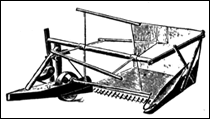
McCormick
Reaper
Two workable horse-drawn reapers patented in the
1830s by Cyrus McCormick (some of the ideas apparently came from a
slave he owned) and Obed Hussey, both using vibrating blades, in
Hussey's case moving in a slot in a series of guide teeth.
The McCormick reaper could cut 15 acres of wheat a day. A man with
a scythe and cradle could cut only 3 acres. Not widely used until
about 1855.
- McCormick didn't have the most uniform or
satisfactory product but he moved his factory from Virginia to
Chicago to be nearer the demand while Hussey stayed in
Baltimore.
- McCormick succeeded by advertising and
demonstrations, and by developing exclusive dealerships and
selling machines on credit.
- Manufactured by regional franchises until
1851, at which point his production was 1000 per year.
Even his steam-powered plan in Chicago in 1850 depended on
skilled workers, not special-purpose machines.
- Annual new model made manufacturing
innovations difficult and meant replacement parts were an
incredible headache--this wasn't a conscious marketing
strategy but a combination of improvements and meeting the
expectations of farmers.
- Even in the 1870s, factory manager Leander
McCormick did not want to expand production and was notably
unknowledgeable about machine tools--ordered things that did
not exist and asked for parts that were not normally supplied
(Chicago too far from New England, for one thing).
- Only introduced mass production techniques in
1880, when Cyrus kicked out Leander and hired Lewis Wilkinson,
who had worked at both the Colt Armory and the Wilson Sewing
Machine company. Production increased fivefold by 1902.
Widespread use of these machines came with Civil War
- labor shortage and high prices resulting
from the civil war--farmers had cash to buy machines.
- When prices went down after the war farmers
had to expand and mechanize to keep up. Farm workers 64%
of labor force in 1850, 49% in 1880.
- Machine farming developed on a large scale
with settling of western Great Plains, 1870-1890.
- Rainfall of less than 15 in/yr and required
wells 50-500 feet deep (windmills scarce until 1900).
Open range pretty much gone by 1890s; ranching took advantage
of barbed wire (invented in 1874) to fence grazing land.
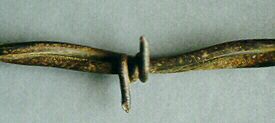
Glidden's
1874
barbed wire design
- 1870s brought first attempts at large-scale,
technology-intensive farming.
- Took advantage of new varieties of wheat
(particularly Russian) that could grow as winter wheat in
cold climates.
- Dry farming techniques--planting in deep
furrows (dust mulch).
- Experiments by people such as Oliver
Dalrymple in mid to late 1870s--Grandin Bonanza, a farm of
61,000 acres worked by 200 pairs of harrows, 155 binders,
16 threshers, combines pulled by teams of 30-50 horses and
mules or by steam tractors. But many large farms
went bankrupt in the droughts of 1885-1890.
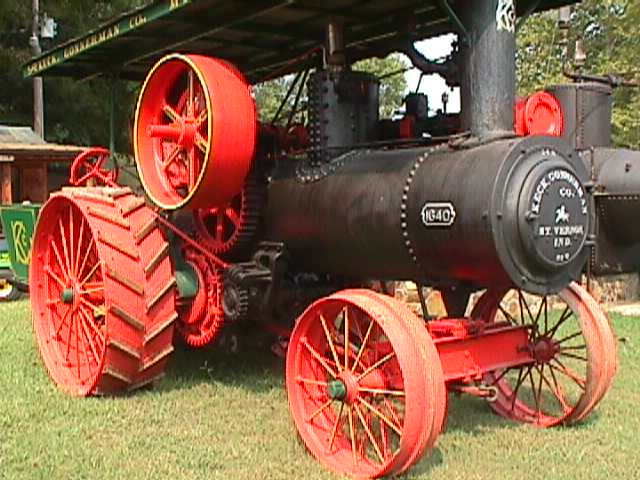
PEM Photo, Steam Tractor, Dacusville Farm Days
Enthusiasm continued for steam tractors despite
usefulness only on hard soils (14 hp steam engine weighed 12,000
lbs.).
- By 1900 5000 steam tractors made per year.
- Required many men to operate and much carrying
of supplies, not to mention danger of setting fields on fire
with sparks from the engine.
Tractors with internal
combustion engines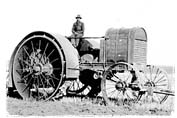
- it wasn't easy to build a machine to replace horses in
a muddy field
- steam
tractors were a success for logging and for farms in the
western great plains in the 1890s
- tractors with internal combustion engines were
on the market as early as 1904
- D.M.
Hartsough built a multicylinder tractor that evolved
into a successful model called "the big four"
- period of many different companies trying different
approaches
- produced his first experimental tractor,
which he called an automobile
plow , in 1907
- Fordson model F production started in 1917
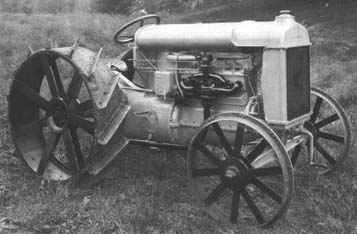
Fordson
Model
F
- this was good timing, just when World War I
was causing a desperate manpower shortage for farmers and
higher prices so they could afford to buy equipment
- Like the Model T, Ford made a smaller, less
expensive, easier to maintain tractor
Impact
- tractors were most useful on larger farms in relatively
flat terrain with hard soil
- in the south they weren't necessarily more economical
than mules for small farms even in the 1930s
- the more farmers have to spend on equipment the more
dependent they are on crop prices


 Archimedes
Archimedes





 23. Life
and Miracles of Saint Louis
23. Life
and Miracles of Saint Louis  The printing press
allowed knowledge to spread more quickly and reliably:
The printing press
allowed knowledge to spread more quickly and reliably:









